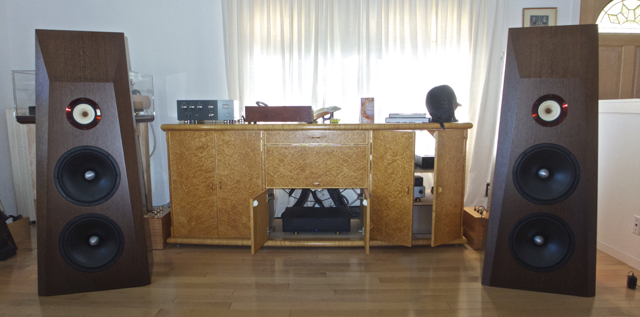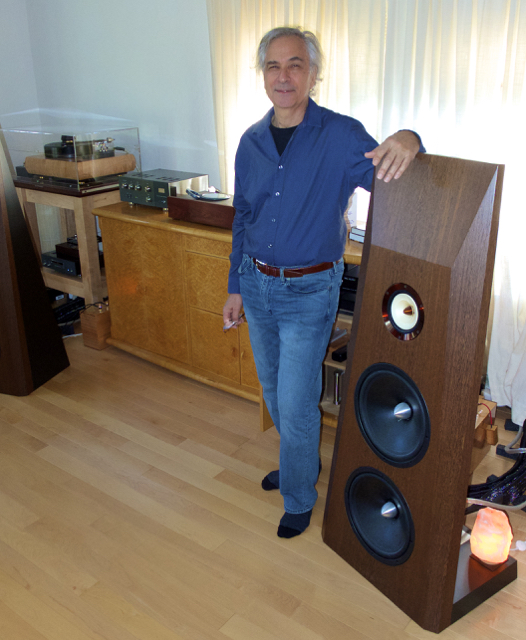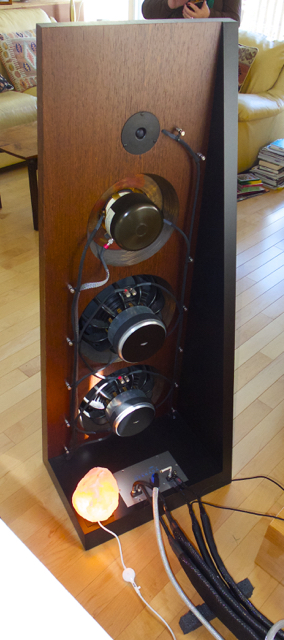
Joe Cohen of The Lotus Group invited Becky and me to come over to his place to hear his Granada speakers that he is putting back into production. So, on a beautiful fall day in northern California, Becky and I headed over to Marin to give them a listen. We had a great time getting to know Joe and listening to his wonderful system. Joe is without a doubt one of the truly nice guys in audio, down to earth and very knowledgeable. I particularly appreciated that Joe had such kind things to say about other speaker and cable designers.
Technology and Tradition
 Joe started his audio journey as an audio hobbyist and freely admits that he isn’t an engineer. In the 80’s, he and some buddies got together regularly to listen to equipment. “We understood that cables could make a difference, but there were very limited offerings at the time,” he said. He started playing around with building cables by buying every gauge of copper wire they had at his local Radio Shack store. The first cables he built were an improvement over what he had used previously. A friend’s Litz interconnects planted a seed in his mind as to how much difference cables make. A few more years went by and a few more lessons learned led to the development of his own, PranaWire.
Joe started his audio journey as an audio hobbyist and freely admits that he isn’t an engineer. In the 80’s, he and some buddies got together regularly to listen to equipment. “We understood that cables could make a difference, but there were very limited offerings at the time,” he said. He started playing around with building cables by buying every gauge of copper wire they had at his local Radio Shack store. The first cables he built were an improvement over what he had used previously. A friend’s Litz interconnects planted a seed in his mind as to how much difference cables make. A few more years went by and a few more lessons learned led to the development of his own, PranaWire.
The system we listened to was truly world class. The source was a turntable that Joe designed and made, the tonearm was from Durand, and the cartridge was an Ortofon Windfeld. The preamp was from Air Tight, and the power amp for the Feastrex field coil drivers was from SMc Audio, and of course, all the cabling was Joe’s own PranaWire.
We went over to hear the speakers, and they did not disappoint. Joe said the Granadas were designed to show the potential of the Feastrex field coil drivers. The Granadas represent the past and the future of speaker design.The Feastrex field coil drivers use of the world’s finest handmade washi paper from Japan for the cones. They are made by Ichibei Iwano San, a ninth-generation master washi papermaker who has been designated as a Japanese National Living Treasure. He actually came up with a special formula that he uses to make these cones. It’s called Hosho Shi paper and was developed in the Japanese middle ages The surrounds are made of the highest quality lambskin leather, and in this model, they use a field coil instead of a magnet. The Feastrex drivers used in the Granadas cost $30,000 per pair.
I will never forget the impression this driver made on me at RMAF 2008 and then at Constantine Soo’s house when he reviewed them in 2009 for Dagogo. I still have never heard a better midrange speaker, but it just didn’t have any bass. The Feastrex field coil drivers were mounted in Urushi lacquer coated enclosures built by Makoto Tanaka. Urushi lacquer, once cured, is said to be among the most impervious finishes known. This single-driver speaker was extremely coherent, with extremely fast micro dynamics and was just beautiful to listen to, but it really wasn’t a full-range speaker.
Joe said the Granada came about because of his desire to design a speaker that took full advantage of the greatest strengths of the world’s finest handmade washi paper cones and to augment those strengths so that a new, and previously unheard level of performance. They chose to go with an open baffle design trying to get bass that was as fast as the Feastrex driver and to eliminate any boxy sound in the bass. The speaker drivers breathe naturally and present their pristine qualities. No box means bass that it is clear and powerful and much less susceptible to room excitations. The baffle is machined from a three-inch slab of Finnish Birch plywood, not MDF which will deaden the sound. The pair we listened to were made from Makassar in a beautiful natural finish, but they can build your pair with any veneer, laminate or automobile finish that suits your taste.
Each speaker is 22 inches wide, 54 inches tall and the base is 16 inches deep. Each speaker has a 5-inch Feastrex field coil driver with their power supplies and two 12 inch dual voice coil woofers. It uses an active digital crossover with a 500-watt amp for the woofers. All, you need is an amp for the Feastrix drivers. The crossover/amp also has state of the art digital room correction.
The Lotus Group’s engineer is Manny LaCarrubba, former chief engineer of the Record Plant in Sausalito, CA, who is also a recording engineer among other things and also a veteran loudspeaker designer with several patents in the field of loudspeaker design. Now, Joe met Manny through his UPS driver who told him he should meet the guy around the corner who was also in the audio business and gave him the neighbor’s address. Joe went over and introduced himself, and the guy turned out to be Manny. What a way to make an introduction!
If you purchase a pair of the Granada speakers, they will voice them to your room. This is done with a total of 72 measurements taken over 360 degrees in the horizontal plane and 360 degrees in the vertical plane to measure axial frequency response, overall power response and primary listening window response. The subtle adjustments can be made as needed to assure that the Granada remains faithful to the artistry of the Feastrex driver. Of course, if you move them later, it will affect the voicing.
The Listening Experience

We first listened to Joni Mitchell’s album “Mingus,” we listened to the first side, and the sound was incredible. The bass was fast and very dynamic, and her voice sounded so alive. When I heard her voice, my mind went back to hearing the Feastrex speakers back in 2008 and 2009 except now there was plenty of bass. Wayne Shorter’s saxophone was right there in its own space. The micro-dynamics of the percussions were amazing. The soundstage was huge, deep and layered.
The next LP we listened to was Johnny Hartman’s I Just Dropped By To Say Hello. His voice was rich with beautiful space and air around it. He sings with an all-star band including saxophonist Illinois Jacquet, guitarists Kenny Burrell and Jim Hall help out on a few tunes, pianist Hank Jones, bassist Milt Hinton, and drummer Elvin Jones. Everything sounded incredible except for the bass, which sounded a little thin and distant from the rest of the music. As we listened to other LPs it became obvious to me it wasn’t the speakers but the recording.
Then Joe put on Patricia Barber’s Modern Cool; we listened to several cuts including “Constantinople.” The soundstage was again very impressive. The bass was well controlled, and again the microdynamics were very fast, and the overall dynamics were huge. After that we listened to Ray Brown’s Soular Energy, which is one of my favorite LPs. It was easy to hear the sound and technique of both Brown on bass and Harris on piano. The sound was full and soulful. We finished the listening session with another of my favorite LPs, Sauerkraut ‘N Solar Energy featuring Norman Blake, Jethro Burns, Sam Bush, Vassar Clements, David Holland, Butch Robins, and Tut Taylor. This is about as good as ‘Dawg’ music gets. Jethro Burns and Sam Bush’s mandolin were alive and very fast. Vassar Clements’ fiddle was quick and lively. The banjo played by Butch Robins and the dobro player, Tut Taylor, were quick and lively. All of these instruments were placed nicely on the soundstage. This is a great LP to show off the capabilities of the Feastrex field coil driver.
Concluding Thoughts
In no way is this post intend as a review of the Granada speakers. I have never had a single piece of this system in my listening room. Still, I feel there are a few things I can safely say about the Lotus Group’s Grenada speakers. First, they have managed to get the best results I have heard from any speaker that tries to combine a full-range driver with woofers, passive or powered, or subwoofers, powered or passive. I expect this is because of the incredible Feastrex field coil driver and the design choices made by the team at Lotus Group.
Second, they combine many of the very best things about speakers that are based on vintage craftsmanship and what audiophiles have come to expect from modern cost-is-no-object speaker designs.
Lastly, my very personal opinion, I’m not quite ready to say I’m a huge fan of open baffle speakers but the Granada and Clayton Shaw’s new Spatial X1 Uniwave may just make one out of me. Oh, they both use an active crossover and are bi-amped. Count me impressed!
